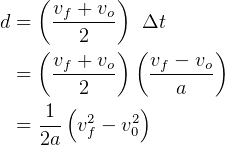


 and
and 
Kinematics: The word is derived from a Greek word meaning 'motion'. Kinematics is the study of motion of objects without direct reference to the forces causing the motion. Kinematics is also the study of the geometry of motion.
In kinematics, we study of the relationship between the displacement, velocity, and acceleration.
In Dynamics, Forces are added. We study the motion of objects, and the affect and interaction of forces on this motion.
The object whose motion we study can be a particle, or a large body. Its motion can be in a straight line, or it can be rotational.
Notations:  is initial velocity.
is initial velocity.  is final velocity.
is final velocity.  is elapsed time.
is elapsed time.  is acceleration.
is acceleration.
Now we derive the compete set of equations of motion to describe motion of a particle in a straight line when the acceleration is constant.
Since we assume that acceleration is constant, then the instantaneous acceleration is the same as the average acceleration and is given by
 | (1) |
And since the acceleration is constant, then the average velocity is
 | (2) |
From the above 2 equations, we can now derive the 4 kinematics equations for motion on a straight line with constant acceleration as follows
We obtain the first kinematic equation from (1) by solving for 
 | (1A) |
Now, suppose we are given  how can we find
how can we find  the displacement?
the displacement?
By definition,

Now substitute (2) in the above we obtain the second kinematic equation
 | (2A) |
Now, suppose we want to find displacement, but are not given the final velocity  ?
?
Substitute (1A) in (2A) we obtain the third kinematic equation
 | (3A) |
Now, suppose we want to find final velocity  but are not given
but are not given  ?
?
From (1) we solve for 

Substitute the above in (2A) we obtain

Solve the above for 
 | (4A) |
This completes the derivation of the 4 kinematic equations for linear motion with constant acceleration. The equations are (1A), (2A), (3A), and (4A)